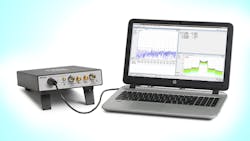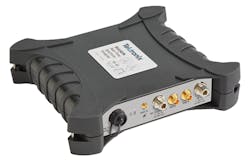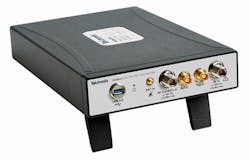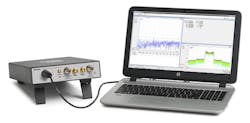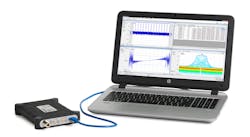Analyzers Squeeze Real-Time Power into Portable Packages
This file type includes high resolution graphics and schematics when applicable.
Portable spectrum analysis once required hoisting an instrument with more mass than a car battery. Fortunately, with the introduction of the RSA500A and RSA600A series of real-time spectrum analyzers from Tektronix, portable real-time spectrum analysis no longer requires a weightlifter’s physique.
These “little boxes” bring all the measurement power of those traditionally larger spectrum analyzers and then some, with total frequency coverage of 9 kHz to 7.5 GHz and capture bandwidths as wide as 40 MHz. The secret is in moving all the command, control, and display capabilities to a personal computer (PC) via a Universal Serial Bus (USB) 3.0 connection, significantly cutting the size and cost of the test instruments.
With a tablet or laptop PC in control, these real-time spectrum analyzers deliver all the measurement power of benchtop instruments, but in form factors that make it easy to test in the lab or in the field. They are ideal for such tasks as spectrum management, Internet of Things (IoT) design, and network maintenance.
The new instruments include the battery-powered RSA500A Series analyzers, featuring the 9-kHz-to-3-GHz model RSA503A and 9-kHz-to-7.5-GHz model RSA507A (Fig. 1). Also included are the slightly larger AC-powered RSA600A series analyzers, which include the 9-kHz-to-3-GHz model RSA603A and 9-kHz-to-7.5-GHz model RSA607A (Fig. 2). Anyone accustomed to a traditional portable spectrum analyzer—with a built-in screen, control panel, and carrying handle—may not even recognize these compact units as spectrum analyzers.
Part of their portability lies within the operating system itself, contained within the versatile SignalVu-PC measurement software which is provided free of charge with each spectrum analyzer. The software can transform any compatible computer into the control panel and display screen, using a USB 3.0 connection to one of the portable analyzers to create a powerful (albeit compact) measurement solution (Fig. 3) at a fraction of the cost of a conventional all-in-one spectrum analyzer.
The battery-powered RSA500A Series real-time spectrum analyzers parlay a superheterodyne receiver architecture with a 14-b, 112 MSamples/s analog-to-digital converter (ADC) into full-sized spectrum-analysis capabilities. They are lightweight with a rugged enclosure, and designed for field use when combined with a Windows-compatible (Windows 7 or newer) tablet or laptop and SignalVu-PC software. At least 20 GB available hard-disk memory is required for the SignalVu-PC software. For those in need of a controller for any of the portable real-time spectrum analyzers, Tektronix offers an accessory PC as an option: a Panasonic FZ-G1 tablet computer with USB 3.0 port.
The FZ-G1 tablet is equipped with an Intel Core i5 microprocessor, 8 GB of random access memory (RAM), and a 256-GB solid-state drive for data storage. The tablet features an integrated microphone and speaker, and shows captured signals on a 10.1-in. (25.6-cm) daylight-readable screen. The tablet has integrated battery backup for ease of swapping battery packs when making extended measurements in the field.
The RSA500A spectrum analyzers, in 3.0- and 7.5-GHz models, operate continuously for about four hours on a single +14.4-V dc lithium-ion rechargeable battery. They can also be powered by an external DC source (from about +12 to +20 V dc) and via AC power (using an AC adapter). They measure just 11.78 × 10.68 × 2.65 in. (299.1 × 271.3 × 67.3 mm) and weigh only 6.6 lbs (2.99 kg) with battery.
These small instruments provide big measurement power, however, with a reference level range that can be set from -170 to +40 dBm and input attenuation that can be adjusted from 0 to 51 dB in 1-dB steps. The analyzers can safely handle as much as 2 W (+33 dBm) input power from 10 MHz to 7.5 GHz with RF attenuation of 20 dB or more.
Built-in preamplifier gain is 30 dB at 2 GHz and 24 dB at 6 GHz for boosting and capturing low-level signals. The RSA500A real-time spectrum analyzers feature amplitude accuracy of typically ±0.8 dB from 9 kHz to 3 GHz and ±1.5 dB from 3.0 to 7.5 GHz without the preamplifier.
The third-order intercept with the preamplifier off is typically +10 dBm from 9 kHz to 25 MHz, +15 dBm from 25 MHz to 3 GHz, +8 dBm from 3 to 6 GHz, and +10 dBm from 6.0 to 7.5 GHz. The third-order intermodulation distortion is typically -74 dBc measured at 2.120 GHz.
The second-harmonic distortion with the preamplifier off is typically -75 dBc or better across the full frequency range. Residual spurious levels are ≤-75 dBm from 500 kHz to 60 MHz, ≤85 dBm from 60 to 80 MHz, and ≤-100 dBm from >80 MHz to 7.5 GHz.
The battery-powered RSA500A Series portable analyzers are stable with frequency even in the small package. They exhibit ±1 × 10-6 initial frequency accuracy following calibration after a 30 minute warmup time and ±1 × 10-6 typical aging after the first year of operation. They show cumulative frequency error of ±3 × 10-6 with temperature and aging after one year, and frequency drift with temperature of ±0.9 × 10-6 from -10 to +60°C.
As with the RSA600A analyzers, the RSA500A instruments allow users to connect an external reference oscillator (with BNC connector) for enhanced frequency accuracy, working with reference oscillators from 1 to 20 MHz in 1-MHz increments and at power levels from -10 to +10 dBm.
For laboratory or desktop use, the RSA600A Series real-time spectrum analyzers includes two models for use up to 3.0 and 7.5 GHz, with performance levels essentially equivalent to those of the RSA500A analyzers, but without the batteries. The RSA600A series analyzers are designed for use with AC power, with maximum power dissipation of 45 W when the analyzer is fully loaded. They are compact, measuring 14.12 × 8.75 × 2.95 in. (358.6 × 222.3 × 75.0 mm) without the reinforced housing of the RSA500A Series analyzers, and weighing 6.15 lb. (2.79 kg).
Both series of portable analyzers are available with an optional (Option 04) tracking generator covering 10 MHz to 3.0 GHz for the model RSA603A/503A analyzers and 10 MHz to 7.5 GHz for the model RSA607A/507A spectrum analyzers. Both versions of the tracking generator offer 100-Hz frequency resolution with -3-dBm maximum output power and sweep speeds of 6,700 MHz/s for 101 points and 50-kHz resolution bandwidth. The tracking generators connect to the analyzers by means of a Type-N coaxial connector.
Defining Applications
While the portable RSA500A and RSA600A Series real-time spectrum analyzers provide the raw measurement power, the versatile SpectrumVu-PC test software provides the means to tailor the instruments for specific measurement applications—from audio through microwave frequencies. The software has been enhanced with an updated, easy-to-use user interface and a number of new options and capabilities, including support for mapping detected signals (with GPS receivers built into the RSA500A and RSA600A analyzers), channel navigation, and signal classification.
The basic SpectrumVu-PC software package contains a large number of program functions for essential measurements, such as basic spectrum analysis; analog modulation analysis including amplitude modulation (AM), frequency modulation (FM), and phase modulation; spurious signal analysis; DPX spectrum measurements; signal recording; pulse measurements (to a minimum pulse width for detection of 150 ns); and vector signal analysis. The latter includes measurements of amplitude versus time, frequency versus time, phase versus time, and in-phase (I) and quadrature (Q) signal components versus time.
The software also includes functions for measuring complementary cumulative distribution function (CCDR), multiple channel power measurements (MCPM), and occupied bandwidth (OBW) measurements, among others. In addition, a large number of application-specific function modules are available for the SpectrumVu-PC software, such as for performing standards-specific WLAN measurements, Bluetooth measurements, LTE downlink RF measurements, and signal survey and classification functions.
For example, using SpectrumVu-PC software with one of the analyzers and the DPX spectrum display enables analysis of 10,000 spectra per second. For pulsed or intermittent signals, the analyzers provide 100% probability of detection of signals as brief as 100 μs across a 40-MHz span. Captured signals and modulation are shown with vivid clarity using 201 × 801 dpi DPX bitmap resolution.
This measurement and display capability with SignalVu-PC signal analysis software is ideal for analyzing signals with a wide range of digital modulation formats, including binary phase-shift keying (BPSK), frequency-shift keying (FSK), minimum-shift keying, quadrature amplitude modulation (QAM), and quadrature phase-shift keying (QPSK). The software permits signals to be displayed in multiple domains, such as the frequency domain, time domain, and modulation domain, for a better understanding of captured signal characteristics.
Whether selecting a battery-powered RSA500A spectrum analyzer or an AC/DC-line-powered RSA600A Series instrument (see sidebar), each includes a GPS/GLONASS receiver for position marking and tracking. In addition to the tracking generator, a number of options are available for each of the portable analyzers, including the DFA-0047 Smart Antenna from Alaris Antennas.
The antenna has a frequency range of 20 MHz to 8.5 GHz and available extension from 9 kHz to 20 MHz (in the form of a 0.3-m loop antenna). Its built-in USB compass simplifies locating interference and tracking the direction of signals of interest. A trigger control allows one-hand operation when switching an analyzer’s preamplifier on and off for gauging signal levels across a wide dynamic range. P&A: (RSA500A Series): $5,900 and up (3-GHz models) and $9,900 and up (7.5-GHz models); (RSA600A Series): $6,900 and up (3-GHz models) and $9,900 and up (7.5-GHz models); stock.
Tektronix, Inc., 14200 SW Karl Braun Dr., P.O. Box 500, Beaverton, OR 97077; (877) 977-0425
For General-Purpose Testing
The new RSA500A and RSA600A Series analyzers each provide a great deal of test capability to on-site measurements and laboratories, respectively. But what about users who desire the small size of those USB spectrum analyzers but prefer an instrument with more general-purpose RF measurement capabilities?
As with the RSA500A and RSA600A Series analyzers, the RSA306B real-time spectrum analyzer (see figure) connects to a MS Windows compatible PC via USB 3.0 port. It takes on the measurement “character” of the SignalVu-PC software, performing its many basic measurements as well as any specialized test function modules added to the test program. A MATLAB software driver from The MathWorks is also available for use with the RSA306B for offline signal analysis and study.
The RSA306B has a frequency range of 9 kHz to 6.2 GHz with maximum acquisition bandwidth of 40 MHz and frequency resolution of 1 Hz, and can measure signal amplitudes from -160 to +20 dBm. It can capture pulsed and intermittent signals as brief as 100 μs. This is the smallest of the firm’s portable spectrum analyzers, measuring just 7.5 × 5.5 × 1.25 in. (190.5 × 139.7 × 31.9 mm) and weighing 1.65 lb. (0.75 kg), although it runs on DC or AC line power and lacks the battery-powered mobility of the RSA500A.
Looking for parts? Go to SourceESB.
This file type includes high resolution graphics and schematics when applicable.
About the Author
Jack Browne
Technical Contributor
Jack Browne, Technical Contributor, has worked in technical publishing for over 30 years. He managed the content and production of three technical journals while at the American Institute of Physics, including Medical Physics and the Journal of Vacuum Science & Technology. He has been a Publisher and Editor for Penton Media, started the firm’s Wireless Symposium & Exhibition trade show in 1993, and currently serves as Technical Contributor for that company's Microwaves & RF magazine. Browne, who holds a BS in Mathematics from City College of New York and BA degrees in English and Philosophy from Fordham University, is a member of the IEEE.
